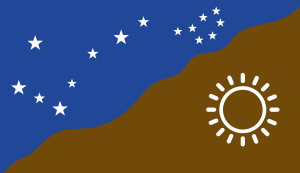Adnyamathanha facts for kids

Flag of the Adnyamathanha people
|
|
| Total population | |
|---|---|
| Unknown (110 recorded fluent speakers of Adnyamathanha language) | |
| Regions with significant populations | |
| Flinders Ranges | |
| Languages | |
| Adnyamathanha, English (Australian Aboriginal English, Australian English) | |
| Religion | |
| Christianity (Baptist), traditional beliefs |
The Adnyamathanha (pronounced: ahd-nya-ma-da-na) are an Aboriginal Australian people. They live in the northern Flinders Ranges area of South Australia. Their name comes from "adnya" (rock) and "matha" (group of people). So, it means "rock people".
The Adnyamathanha people often call themselves "yura". They call their traditional language "yura ngarwala", which means "our speech". Many Adnyamathanha people live in a community called Nepabunna. This community is near the Gammon Ranges. It was started in 1931. Since 1998, the Adnyamathanha people have managed Nantawarrina. This was the first Indigenous Protected Area in Australia.
Contents
Adnyamathanha Lands
The Adnyamathanha people's traditional lands are very important to them. These lands stretch from the northern Flinders Ranges down to Port Augusta. They also go east towards Broken Hill.
In 2009, the Federal Court of Australia officially recognized the Adnyamathanha people's native title rights. This means they have special rights over about 41,000 square kilometers of their traditional land. This area includes parts of the northern Flinders Ranges.
Nantawarrina is a special area managed by Indigenous rangers. They work hard to protect the native plants and animals there. In 2016, the Flinders Ranges National Park was renamed Ikara-Flinders Ranges National Park. Ikara means "meeting place" in the Adnyamathanha language. It refers to Wilpena Pound, a traditional meeting place for the Adnyamathanha people.
Who are the Adnyamathanha People?
The Adnyamathanha group includes several different peoples. These include the Wailpi, Guyani, Jadliaura, Pilatapa, and sometimes the Barngarla peoples.
The name Adnyamathanha means "rock people". This name refers to groups who lived near the lakes in that area. They share a strong common identity. This bond comes from their ancestors, language, and culture, known as Yura Muda.
Adnyamathanha Language
The Adnyamathanha language is part of the Thura-Yura language family. It is one of the few languages from this family that still has people who speak it fluently.
Stories and Stars
The Adnyamathanha people have many creation stories that explain their origins. These stories are passed down through generations. One important creator figure is the Rainbow Serpent, known as akurra.
They also have special names for stars and constellations. The Pleiades (Seven Sisters) are called the Makara. They are seen as women with pouches, like marsupials. The Magellanic Clouds are known as Vutha Varkla. These are seen as two male lawmen.
Adnyamathanha people have great respect for lizards, like geckoes and goannas. Their myths explain this respect. They tell a story about the cannibal sun goddess Bila. She was defeated by the Lizard Men, Kudnu and Muda.
History with Europeans
In 1851, the first Europeans started to settle on Adnyamathanha land. This caused many problems. The Adnyamathanha people were pushed off their land. Europeans set up farms on these lands. When their land, food, and water were taken, Aboriginal people sometimes took sheep. This led to conflicts and killings.
However, many Aboriginal people also worked as stockmen and housekeepers for the settlers. By the 1900s, the Adnyamathanha people began to adopt Western clothes and ways of life.
Even so, they kept their language and culture strong. They would gather at places like Mount Serle Station. This was a special cultural site. There, they spoke their languages and shared their traditional knowledge. Later, many moved to the Nepabunna Mission when it was set up in 1931. Some mission residents even worked at R. M. Williams's workshop nearby. This helped Williams build his famous boot business.
Recording Culture
In 1937, a group from the University of Adelaide visited Nepabunna. They wanted to learn about the Adnyamathanha people. Charles P. Mountford was one of them. He was very interested in their art, stories, and rituals. He came back many times to record the Adnyamathanha language and culture.
The Mountford-Sheard Collection at the State Library of South Australia holds many of his handwritten journals, photos, and sound recordings. This collection helps us understand the Adnyamathanha culture.
Adnyamathanha Flag
In 2011, a special flag for the Adnyamathanha people was created. It was raised at Nepabunna to celebrate its 80th anniversary.
Exhibition
In 2017, the State Library of South Australia held an exhibition called UNSETTLED. It showed many photos taken by Charles P. Mountford in the Flinders Ranges. Adnyamathanha descendants shared their stories to go along with the photos.
Notable People
- Adam Goodes is a famous AFL footballer. He is an Adnyamathanha and Narungga man.
- Rebecca Richards was the first Aboriginal Rhodes Scholar. She is an Adnyamathanha and Barngarla woman.
- Regina McKenzie is an artist. Her works are in the National Museum of Australia. She also won an award for protecting the land.
- Juanella McKenzie is an artist and Regina McKenzie's daughter. Her art is also in the National Museum of Australia and the National Museum of Scotland. She has won several awards for her art.
- Terrence and Josephine Coulthard wrote the first Adnyamathanha/English bilingual dictionary. Their family also runs a cultural tourism business called Iga Warta near Nepabunna.
See also


